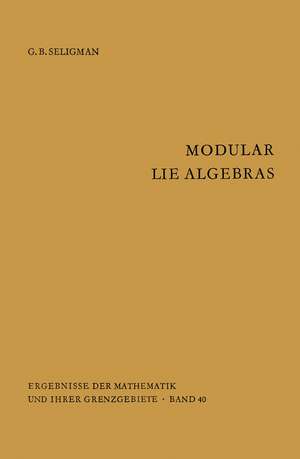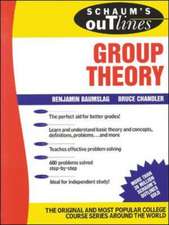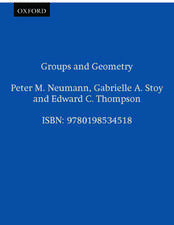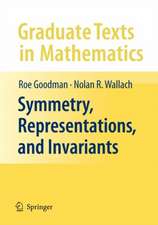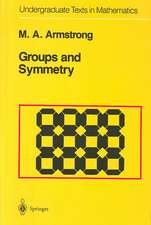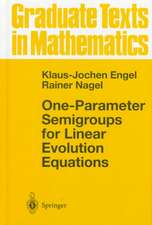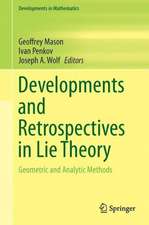Modular Lie Algebras: ERGEBNISSE DER MATHEMATIK UND IHRER GRENZGEBIETE 2 FOLGE, cartea 40
Autor Geoge B. Seligmanen Limba Engleză Paperback – 12 feb 2012
Din seria ERGEBNISSE DER MATHEMATIK UND IHRER GRENZGEBIETE 2 FOLGE
-
 Preț: 442.02 lei
Preț: 442.02 lei -
 Preț: 409.43 lei
Preț: 409.43 lei -
 Preț: 484.47 lei
Preț: 484.47 lei -
 Preț: 376.96 lei
Preț: 376.96 lei -
 Preț: 491.72 lei
Preț: 491.72 lei - 15%
 Preț: 704.04 lei
Preț: 704.04 lei -
 Preț: 345.71 lei
Preț: 345.71 lei -
 Preț: 383.12 lei
Preț: 383.12 lei -
 Preț: 382.95 lei
Preț: 382.95 lei - 15%
 Preț: 636.45 lei
Preț: 636.45 lei -
 Preț: 489.87 lei
Preț: 489.87 lei -
 Preț: 387.75 lei
Preț: 387.75 lei - 15%
 Preț: 493.56 lei
Preț: 493.56 lei -
 Preț: 393.35 lei
Preț: 393.35 lei -
 Preț: 377.95 lei
Preț: 377.95 lei -
 Preț: 384.31 lei
Preț: 384.31 lei -
 Preț: 413.07 lei
Preț: 413.07 lei -
 Preț: 380.25 lei
Preț: 380.25 lei -
 Preț: 412.68 lei
Preț: 412.68 lei -
 Preț: 385.62 lei
Preț: 385.62 lei -
 Preț: 415.39 lei
Preț: 415.39 lei -
 Preț: 376.59 lei
Preț: 376.59 lei -
 Preț: 379.48 lei
Preț: 379.48 lei -
 Preț: 483.27 lei
Preț: 483.27 lei -
 Preț: 414.42 lei
Preț: 414.42 lei - 15%
 Preț: 579.67 lei
Preț: 579.67 lei - 15%
 Preț: 636.63 lei
Preț: 636.63 lei -
 Preț: 419.06 lei
Preț: 419.06 lei - 18%
 Preț: 1108.67 lei
Preț: 1108.67 lei - 15%
 Preț: 578.37 lei
Preț: 578.37 lei -
 Preț: 381.43 lei
Preț: 381.43 lei -
 Preț: 383.12 lei
Preț: 383.12 lei -
 Preț: 375.45 lei
Preț: 375.45 lei -
 Preț: 171.74 lei
Preț: 171.74 lei -
 Preț: 150.03 lei
Preț: 150.03 lei -
 Preț: 413.27 lei
Preț: 413.27 lei -
 Preț: 410.17 lei
Preț: 410.17 lei -
 Preț: 381.21 lei
Preț: 381.21 lei -
 Preț: 383.12 lei
Preț: 383.12 lei -
 Preț: 480.83 lei
Preț: 480.83 lei -
 Preț: 375.62 lei
Preț: 375.62 lei -
 Preț: 382.36 lei
Preț: 382.36 lei -
 Preț: 383.50 lei
Preț: 383.50 lei -
 Preț: 181.74 lei
Preț: 181.74 lei -
 Preț: 408.77 lei
Preț: 408.77 lei -
 Preț: 359.54 lei
Preț: 359.54 lei -
 Preț: 376.43 lei
Preț: 376.43 lei
Preț: 381.00 lei
Nou
Puncte Express: 572
Preț estimativ în valută:
72.91€ • 76.03$ • 60.60£
72.91€ • 76.03$ • 60.60£
Carte tipărită la comandă
Livrare economică 21 martie-04 aprilie
Preluare comenzi: 021 569.72.76
Specificații
ISBN-13: 9783642949876
ISBN-10: 3642949878
Pagini: 180
Ilustrații: X, 166 p.
Dimensiuni: 152 x 229 x 9 mm
Greutate: 0.25 kg
Ediția:Softcover reprint of the original 1st ed. 1967
Editura: Springer Berlin, Heidelberg
Colecția Springer
Seria ERGEBNISSE DER MATHEMATIK UND IHRER GRENZGEBIETE 2 FOLGE
Locul publicării:Berlin, Heidelberg, Germany
ISBN-10: 3642949878
Pagini: 180
Ilustrații: X, 166 p.
Dimensiuni: 152 x 229 x 9 mm
Greutate: 0.25 kg
Ediția:Softcover reprint of the original 1st ed. 1967
Editura: Springer Berlin, Heidelberg
Colecția Springer
Seria ERGEBNISSE DER MATHEMATIK UND IHRER GRENZGEBIETE 2 FOLGE
Locul publicării:Berlin, Heidelberg, Germany
Public țintă
ResearchCuprins
I. Fundamentals.- 1. Definitions.- 2. The Poincaré-Birkhoff-Witt theorem.- 3. Free Lie algebras. Restricted Lie algebras.- 4. Iwasawa’s theorem.- 5. Nilpotent Lie algebras. Engel’s theorem.- 6. Cartan subalgebras.- 7. Semisimplicity. The Killing form.- 8. Trace forms, derivations, and restrictedness.- 9. Extension of the base ring.- II. Classical Semisimple Lie Algebras.- 1. The Cartan decomposition.- 2. Split 3-dimensional algebras and applications.- 3. Classical Lie algebras.- 4. Strings of roots and Cartan integers.- 5. Fundamental root systems.- 6. Semisimplicity and simplicity.- 7. Determination of the fundamental systems.- 8. Existence of isomorphisms.- 9. The Weyl group.- 10. Existence of the classical algebras.- 11. Generalizations of the theory.- III. Automorphisms of the Classical Algebras.- 1. The Chevalley groups.- 2. The fundamental decomposition of G. Consequences.- 3. Structure of the Chevalley group.- 4. Conjugacy of Cartan subalgebras.- 5. Structure of the automorphism group.- 6. Realizations.- IV. Forms of the Classical Lie Algebras.- 1. Forms and splitting fields.- 2. Galois semi-automorphisms and 1-cohomology.- 3. Simple involutorial algebras and the types A — D.- 4. Derivation algebras of alternative and Jordan algebras.- 5. Other types.- 6. Finite fields.- 7. On automorphism groups.- V. Comparison of the Modular and Non-modular Cases.- 1. Solvable and nilpotent algebras.- 2. Representations.- 3. Cohomology.- 4. Known simple Lie algebras.- 5. Derivations.- 6. Extension of the base field.- 7. Cartan subalgebras.- 8. Nilpotent elements and special subalgebras.- VI. Related Topics.- 1. Nilpotent groups and Lie algebras. The restricted Burnside problem.- 2. Linear algebraic groups and Lie algebras.- 3. Formal groups, hyperalgebras and Liealgebras.- 4. Lie derivation algebras and purely inseparable extensions.- 5. Infinite-dimensional analogues of the classical Lie algebras.
